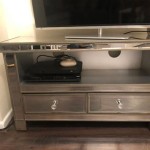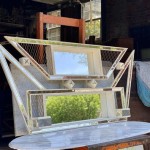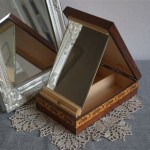Room Mirror Design Ideas: Enhancing Space and Style
Mirrors are more than just reflective surfaces; they are powerful design tools capable of transforming the ambiance and functionality of a room. Strategic placement and design choices can significantly impact the perceived size, light levels, and overall aesthetic appeal of any interior space. This article explores various room mirror design ideas, offering insights into how to effectively utilize mirrors to enhance the visual impact and spatial perception of different room types.
The incorporation of mirrors into interior design is a practice that dates back centuries. Historically, mirrors were symbols of wealth and luxury, often meticulously crafted and displayed as standalone works of art. Today, mirrors are readily accessible and serve a multitude of purposes. They can be used to create focal points, amplify natural light, add architectural interest, and even correct perceived imbalances in a room's layout. The key to successful mirror design lies in understanding the specific characteristics of the space and selecting mirrors that complement and enhance those features.
Maximizing Natural Light and Creating Openness
One of the most effective uses of mirrors in interior design is to maximize natural light. Mirrors strategically placed opposite windows can reflect sunlight deep into the room, effectively doubling the amount of natural light available. This is particularly beneficial in smaller rooms or spaces with limited window access. Furthermore, reflecting light can create a brighter and more inviting atmosphere, improving the overall mood and visual appeal of the space.
The size and placement of the mirror play a crucial role in optimizing light reflection. Larger mirrors, such as full-length mirrors or mirrored walls, can reflect a greater amount of light than smaller mirrors. Positioned directly across from a window, a large mirror acts as a secondary light source, casting light across the room and eliminating dark corners. For rooms with multiple windows, mirrors can be strategically placed to capture light from different angles and distribute it evenly throughout the space.
Beyond light amplification, mirrors also contribute to the perception of spaciousness. By reflecting the surrounding environment, mirrors create an illusion of depth, making a room appear larger than it actually is. This is particularly effective in narrow hallways, small bedrooms, or compact living rooms. A long, horizontal mirror placed along a wall can visually widen the space, while a tall, vertical mirror can create the illusion of higher ceilings.
When using mirrors to create openness, it is important to consider the reflections they will produce. Avoid placing mirrors in locations where they will reflect clutter or unattractive views, as this will detract from the desired effect. Instead, focus on reflecting positive elements of the room, such as artwork, plants, or architectural details. A well-placed mirror can transform a cramped and confined space into a bright and airy environment.
Creating Focal Points and Adding Visual Interest
Mirrors can serve as striking focal points, adding visual interest and character to a room. A carefully selected mirror can draw the eye and become a central element in the overall design scheme. This can be achieved by choosing mirrors with unique shapes, ornate frames, or distinctive finishes. The mirror's placement and surrounding decor should also be considered to maximize its impact.
A large, decorative mirror above a fireplace mantelpiece is a classic example of using a mirror to create a focal point. The mirror reflects the fire and surrounding decor, creating a warm and inviting atmosphere. In a dining room, a large mirror can be hung on a feature wall to reflect light and create a sense of grandeur. The reflection of the dining table and chairs doubles the visual impact of the space, making it feel more spacious and elegant.
Beyond large statement pieces, smaller mirrors can also be used to create visual interest. A gallery wall of different sized and shaped mirrors can add a touch of eclecticism and personality to a hallway or living room. These mirrors don't necessarily need to be functional; their primary purpose is to add visual texture and depth to the space. Mirrors with interesting frames, such as vintage mirrors or mirrors with geometric designs, can further enhance the visual appeal.
When using mirrors as focal points, it is important to consider the overall style of the room. A modern, minimalist room might benefit from a large, frameless mirror, while a more traditional room might call for a mirror with an ornate, gilded frame. The mirror should complement the existing decor and contribute to the overall aesthetic of the space. The surrounding lighting should also be considered to ensure that the mirror is properly illuminated and its features are highlighted.
Integrating Mirrors into Functional Spaces
Mirrors are not only decorative elements but also functional components that enhance the usability of certain spaces. In bathrooms, bedrooms, and dressing rooms, mirrors are essential for grooming, dressing, and applying makeup. Integrating mirrors into these spaces requires careful consideration of functionality, lighting, and ergonomics. The goal is to create a well-lit and user-friendly environment that facilitates daily routines.
In bathrooms, a large mirror above the vanity is a standard fixture. However, the design of the mirror can significantly impact the overall functionality and aesthetic appeal of the space. A mirror with built-in lighting can provide optimal illumination for grooming tasks, eliminating shadows and ensuring accurate makeup application. A fog-resistant mirror can prevent condensation from obscuring the view after a shower, enhancing convenience and usability.
In bedrooms and dressing rooms, full-length mirrors are essential for assessing outfits and ensuring proper fit. These mirrors should be strategically placed to provide a clear and unobstructed view of the entire body. A full-length mirror can be mounted on a wall, hung on the back of a door, or incorporated into a wardrobe. The placement should be chosen to maximize space and minimize clutter.
Mirrored wardrobes and closet doors are another effective way to integrate mirrors into functional spaces. These mirrors not only provide a full-length reflection but also contribute to the perception of spaciousness. They can visually double the size of a small bedroom or dressing room, creating a more open and airy feel. The mirrored surfaces also reflect light, enhancing illumination and reducing the need for additional lighting fixtures.
When integrating mirrors into functional spaces, it is important to consider the practicality and safety aspects. Mirrors should be securely mounted to prevent accidents, and the edges should be smooth and polished to avoid cuts or injuries. The height and angle of the mirror should be adjusted to accommodate the users and ensure a comfortable viewing experience. Proper lighting is also crucial to ensure that the mirror is well-illuminated and the user can see clearly.
Beyond these key points, there are numerous other factors to consider when selecting and installing mirrors. The shape, size, and style of the mirror should be carefully chosen to complement the overall design scheme of the room. The placement of the mirror should be carefully considered to maximize its impact and avoid creating unwanted reflections. The lighting around the mirror should be carefully planned to ensure that it is well-illuminated and its features are highlighted.
Ultimately, the goal of room mirror design is to create a space that is both visually appealing and functionally efficient. By carefully considering the various design ideas and factors outlined in this article, individuals can effectively utilize mirrors to enhance the beauty, functionality, and perceived spaciousness of any room in their home. The strategic use of mirrors can transform a dull and uninspired space into a vibrant and inviting environment.

Mirror Decoration For Home 15 Ideas To Decorate With Mirrors

Image Gallery Page 426153183488350696 Artofit Hall Decor Interior Wall Design Living Room

Trending Bedroom Mirror Ideas In 2024

Decorative Wall Mirrors 40 Design Catalogue For Living Room Hallway Bathroom

Mirror Decoration For Home 15 Ideas To Decorate With Mirrors

25 Wall Mirror Decorating Ideas That Will Enhance Your Home Decor

Stunning Bedroom Mirror Designs To Elevate Your Décor Beautiful Homes

10 Innovative Mirror Uses For Home Interior Design

Wall Mirror Decorating Ideas To Enhance Your Home Decor

Home Interior Design Ideas 10 Creative Ways To Use Mirrors In Your Hipcouch Complete Interiors Furniture








